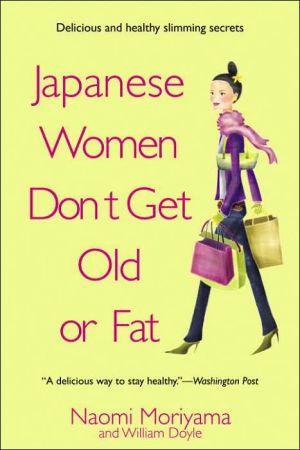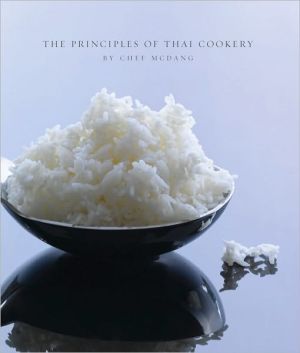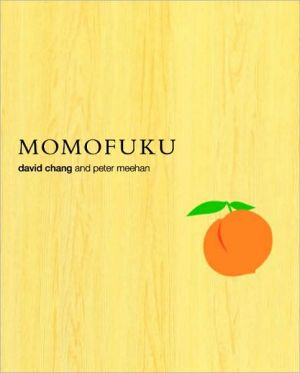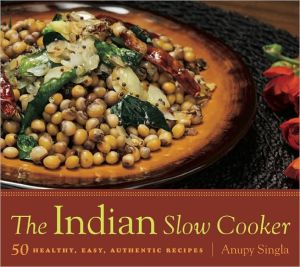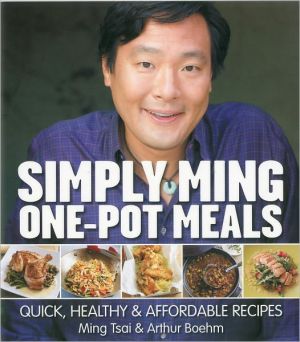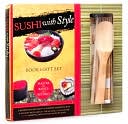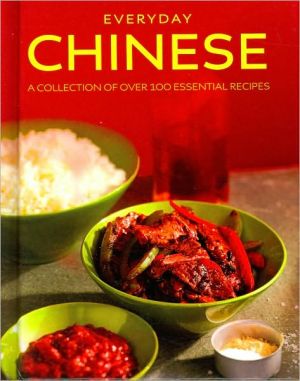Japanese Women Don't Get Old or Fat: Secrets of My Mother's Tokyo Kitchen
What if there were a land where people lived longer than anywhere else on earth, the obesity rate was the lowest in the developed world, and women in their forties still looked like they were in their twenties? Wouldn't you want to know their extraordinary secret?\ Japanese-born Naomi Moriyama reveals the secret to her own high-energy, successful lifestyle–and the key to the enduring health and beauty of Japanese women–in this exciting new book. The Japanese have the pleasure of eating one of...
Search in google:
What if there were a land where people lived longer than anywhere else on earth, the obesity rate was the lowest in the developed world, and women in their forties still looked like they were in their twenties? Wouldn't you want to know their extraordinary secret? Japanese-born Naomi Moriyama reveals the secret to her own high-energy, successful lifestyle and the key to the enduring health and beauty of Japanese women in this exciting new book. The Japanese have the pleasure of eating one of the most delicious, nutritious, and naturally satisfying cuisines in the world without denial, without guilt and, yes, without getting fat or looking old. As a young girl living in Tokyo, Naomi Moriyama grew up in the food utopia of the world, where fresh, simple, wholesome fare is prized as one of the greatest joys of life. She also spent much time basking in that other great center of Japanese food culture: her mother Chizuko's Tokyo kitchen. Now she brings the traditional secrets of her mother's kitchen to you in a book that embodies the perfect marriage of nature and culinary wisdom Japanese home-style cooking. If you think you've eaten Japanese food, you haven't tasted anything yet. Japanese home-style cooking isn't just about sushi and raw fish but good, old-fashioned everyday-Japanese-mom's cooking that's stood the test of time and waistlines for decades. Reflected in this unique way of cooking are the age-old traditional values of family and the abiding Japanese love of simplicity, nature, and good health. It's the kind of food that millions of Japanese women like Naomi eat every day to stay healthy, slim, and youthful while pursuing an energetic, successful, on-the-go lifestyle. Even better, it's fast, it's easy, and you can start with something as simple as introducing brown rice to your diet. You'll begin feeling the benefits that keep Japanese women among the youngest-looking in the world after your very next meal! If you're tired of counting calories, counting carbs, and counting on being disappointed with diets that don't work and don't satisfy, it's time to discover one of the best-kept and most delicious secrets for a healthier, slimmer, and long-living lifestyle. It's time to discover the Japanese fountain of youth. Telegraph (UK) If you need inspiration to change your diet, spending a couple of hours with Moriyama should do the trick. She has a slight (but not too skinny) frame, perfect skin, lots of energy and gleaming hair. She looks 20 years younger than her real age of 45. When buying alcohol, she is often asked for ID, and is regularly quizzed on which university she attends. She is a living example of what most women her age dream of...Japanese people, especially women, are the healthiest in the world.
Chapter 1\ My Mother’s Tokyo Kitchen\ The people assemble in joy;\ Food and drink is abundant.\ For all generations without end,\ Day by day ever more flourishing,\ Until myriads of years hence The pleasure will not cease.\ —Ancient Japanese blessing\ My mother, Chizuko, sends me e-mails from Tokyo all the time. She sends them from her mobile phone–when she’s in the kitchen or the grocery store, when she’s on line to buy tickets to a show, or when she’s waiting for a train in a Tokyo subway station.\ She wants to know how my husband, Billy, and I are doing, when we’re coming over to visit–and what we’re eating.\ To help us write this book, she’s been sending us her recipes and food tips by e-mail and via fax, sometimes writing little diagrams of vegetables like mountain potatoes. She is a self-taught natural master of Japanese home cooking who never refers to a cookbook. “It’s all in my brain,” she explains.\ Like many mothers in Japan and around the world, my mother has always been devoted to giving her family the most healthy and delicious food she can find, as a way of showing her love for them. I see her cooking not just as a sign of love but also as the perfect symbol of why Japanese women are living longer and healthier than everyone else on Earth, and why they (and their husbands) have the lowest obesity rates in the developed world.\ My husband and I both have stories to tell that bring those statistics to life. I’ll start with Billy’s story, which began several years ago, when we stayed at my parents’ apartment in Tokyo for a week and experienced–for the first time, in Billy’s case–a total immersion in my mother’s home cooking. I had been back to Tokyo many times over the years, both on business and to visit my family, but when I was there I usually stayed at hotels like the Park Hyatt (the setting of Sofia Coppola’s Lost in Translation). This time, we chose not to stay in a hotel because my parents insisted on our being with them.\ For me, that week in My Mother’s Tokyo Kitchen was a delicious reawakening to the tastes and aromas of my youth, of the years before I moved to New York at the age of twenty-seven. For Billy, it was a completely new experience. Billy had been to Tokyo with me once before, but on that trip we had separate business meetings in different parts of town, we stayed in a Western-style hotel, and I was too busy to introduce him to the pleasures of Tokyo food, which was completely foreign and intimidating to him.\ He wandered the streets of Tokyo in a state of hungry confusion.\ He looked in shop windows and stared at noodle bowls and bento boxes–and he was clueless. He had no idea what or how to order. The food looked strange and the menus were incomprehensible. Food was everywhere–but to him it all seemed out of reach. So he made a beeline for McDonald’s, and chowed down on Big Macs, shakes, and fries almost every day, he confessed later.\ At the end of four days in Tokyo, he felt lousy and was five pounds fatter. But during his next trip to Tokyo, after a week of eating only the dishes that emerged from My Mother’s Tokyo Kitchen, Billy had fallen madly in love with Japanese home-cooked food. When we went back to New York, he continued eating Japanese-style food almost exclusively.\ For both of us, that week in Tokyo ignited a new passion for the joys of Japanese home cooking. Before that trip, we relied heavily on takeout, frozen dinners, and eating out, just like other New York workaholics. To me, “cooking” meant buying prewashed salad mix from a supermarket, putting it in a pretty bowl, and serving it with a premium-priced dressing. My repertory was otherwise limited to cooking dry pasta in boiling water, sautéing broccoli and tomato, and mixing them with bottled marinara sauce. Preparing a meal from scratch was rare. Who had the time and energy? By the time I left my office in the evening, I was exhausted and left with no brainpower to think about a menu, let alone the energy to wash vegetables and chop them.\ But after that week at my parents’ house, Billy and I started to prepare Japanese-style meals at home more and more often, especially after Billy learned to make rice like a professional and even cook miso soup for breakfast. We quickly realized that we could re-create My Mother’s Tokyo Kitchen at our apartment in New York. I began going to local Japanese grocery stores and Whole Foods for tofu, seasoning products like soy sauce, rice vinegar, and miso soup, and the local green market for fresh vegetables, meat, and fish. The more I visited Japanese grocery stores, the more I remembered the kind of dishes I used to eat when I lived with my parents, dishes like sautéed fish and simmered root vegetables.\ And the most surprising thing was that the more Japanese home cooking we ate, the leaner, more energetic, and more productive we became, while at the same time feeling completely satisfied after every meal. Part of the reason for writing this book was simply to collect Chizuko’s recipes and techniques so we could tape them to our own refrigerator.\ In 2004 we began researching the subject in depth, and discovered a wide range of scientific and journalistic evidence suggesting the health benefits of traditional Japanese home cooking and ingredients and lifestyle habits. This helped explain to us why we looked and felt so much better after we started cooking the way my mother does.\ Japanese food, in many ways, has already become American food.\ But I want to reassure you that this is not a cuisine you will find intimidating, even though aspects of it are very different from what you may be used to.\ Across the nation, Americans have fallen in love with Japanese restaurants and takeout sushi. In Houston alone there are more than a hundred Japanese eateries. Japanese foods and ingredients like edamame, ponzu, wasabi, yuzu and miso have become standard items in non-Japanese restaurant kitchens. Now it’s time to discover Japan’s greatest food secret of all: home cooking.\ I left the comfort of My Mother’s Tokyo Kitchen twice. The first time was when I went away to college;the second was when I moved to New York. But twice I returned to it, each time very glad that I did. And now that I’ve re-created a Tokyo kitchen in my own home, I’ll never leave again, at least not for long.\ ***\ A sample recipe from Japanese Women Don't Get Old or Fat\ Tokyo Salad\ SERVES 4\ Salads in Japan are a relatively modern phenomenon. However, sometimes modern is good, such as in this lively herb-filled medley of greens splashed with a light sesame dressing. Most mesclun salad mixes contain mizuna, a feathery Japanese green that adds an invigorating snap. Enjoy this salad during the warmer months.\ 1/2 pound pencil-thin asparagus, woody stem ends snapped off\ 6 cups mixed baby greens\ 1/2 cup thinly sliced celery\ 1/2 cup diced red bell pepper\ 1 scallion, roots and coarse portion of the tops cut off,\ and thinly sliced\ 2 tablespoons minced cilantro, plus 4 tiny sprigs for garnish\ 5 shiso leaves, thinly sliced\ 1 plum tomato, cored and cut into 12 wedges\ \ Dressing\ 3 tablespoons rice vinegar\ 2 tablespoons minced red onion\ 1 teaspoon light brown sugar\ 1 tablespoon toasted sesame oil Pinch of salt and freshly ground black pepper\ 1. Put 1 cup water in a medium skillet and bring to a boil. Add the asparagus and cook over high heat for 45 seconds, or until a sharp knife easily slides through one stem end. Drain and refresh under cold water. Transfer the asparagus to a plate lined with a double thickness of paper towels and let cool. Cut each spear diagonally into 1-inch-long pieces. Set aside several asparagus tips for the garnish.\ 2. Combine the cooked asparagus, greens, celery, red pepper, scallion, minced cilantro, and shiso in a salad bowl. Gently toss to mix.\ 3. In a small bowl, whisk together the vinegar, red onion, and brown sugar until the sugar is dissolved. Whisk in the sesame oil and season with a generous pinch of salt and several grinds of pepper. Pour the dressing over the salad and gently toss to mix. Lay out 4 salad plates. Arrange a portion of salad on each plate and garnish with 3 tomato wedges, the reserved asparagus tips, and the cilantro sprigs.
\ From Barnes & NobleMireille Guiliano started it with French Women Don't Get Fat. Then Heidi Insalata Krahling countered with Mediterranean Women Stay Slim Too. Now adopted New Yorker Naomi Moriyama explains that the lessons that Japanese women learn in their mother's kitchen help give them the greatest longevity on earth and the lowest obesity rate in the industrialized world. The U.S.-Japan marketing consultant offers convincing proof that the "Nippon advantage" is more than genetic: Her husband (and coauthor) has lost 25 pounds and kept it off since he adopted the Tokyo diet.\ \ \ \ \ Rachel Hartigan SheaMoriyama walks readers through creating a "Tokyo kitchen" in their own home -- rice cooker and wok are optional -- and intersperses her argument for Japanese culinary supremacy with recipes such as "Spinach with Bonito Flakes" and "Salmon-edamame Burger." The result: a delicious way to stay healthy.\ — The Washington Post\ \ \ Washington PostMoriyama walks readers through creating a "Tokyo kitchen" in their own home—rice cooker and wok are optional—and intersperses her argument for Japanese culinary supremacy with recipes...The result: a delicious way to stay healthy\ \ \ \ \ The OregonianNaomi Moriyama has staked out her own territory and written a smart, lively and useful book. While "Japanese Women" is a personal story, it's also well-researched and full of delicious-sounding recipes and tips for learning to cook home-style Japanese foods.\ \ \ \ \ goodhousekeeping.comFor weight loss, I recommend Japanese Women Don't Get Old or Fat: Secrets of My Mother's Tokyo Kitchen, by Naomi Moriyama and William Doyle. One-upping a certain French woman who boasted about staying thing, Moriyama reveals seven secrets of how Japanese women avoid adding pounds and prolong their life.\ \ \ \ \ Cleveland Plain DealerEven the most hesitant readers will find their passion for the wonderful taste and aroma of Japanese dishes irresistible and will be tempted to try some.\ \ \ \ \ AARP Magazine OnlineA tasty mix of easy and adventurous,...the recipes come from Moriyama's mother, whose motto is, 'I use ingredients from the mountains, the oceans and the earth.' If that isn't the Zen of cooking, what it?\ \ \ \ \ Bookseller (UK)After the stodgy excesses of Yuletide, Japanese Women Don't Get Old or Fat will seem like spring come early. This book combines personal memoir, social and political observations, a section for the Samurai in your life, and, naturally, plenty of recipes . . .\ \ \ \ \ Telegraph (UK)If you need inspiration to change your diet, spending a couple of hours with Moriyama should do the trick. She has a slight (but not too skinny) frame, perfect skin, lots of energy and gleaming hair. She looks 20 years younger than her real age of 45. When buying alcohol, she is often asked for ID, and is regularly quizzed on which university she attends. She is a living example of what most women her age dream of...Japanese people, especially women, are the healthiest in the world.\ \ \ \ \ Sunday Telegraph (Australia)Moriyama's book is a compelling wake up call...She gives an easy guide to setting up your own little Tokyo kitchen, with more than 30 recipes handed down form her mother, about whom she writes with great affection. Likewise, she writes about Tokyo in a way that makes you want to get there and into the first noodle house you see. Her descriptions of food and mood would lure the most reluctant gourmet adventurer...Moriyama puts a human face on facts, alternating between personal stories, interesting snippets of Japanese history and the latest research on food and health from a plethora of experts.\ \ \ \ \ Santa Cruz SentinelNaomi Moriyama and William Doyle have laid out a convincing and tasty arguent for cooking the Japanese way in their book...easy to accomplish in your own kitchen.\ \ \ \ \ Publishers WeeklyIt's well known that Japanese women have the lowest obesity rate in the industrialized world (3%) and the highest life expectancy (85 years), and that their cuisine is based on simplicity. Tokyo native Moriyama puts a human face on this phenomenon, that of her mother, Chizuko, in this well-organized, persuasive introduction to a non-Western everyday cooking plan. Just as Moriyama reconstructed Chizuko's cooking practices for herself and her coauthor husband, Doyle (Inside the Oval Office), she shows readers the elements of Chizuko's 6' x 12' Tokyo kitchen. She details its pantry ingredients, including bonito (fish) flakes and daikon (radish) and tools such as a rice cooker and wok. Most recipes are based on at least one of the "seven pillars"-fish, vegetables, rice, soy, noodles, tea, fruit-and are familiar and easy to make (Shrimp and Vegetable Tempura, Teriyaki Fish, etc.). Cooking tips abound, but what adds a French Women Don't Get Fat angle is the useful eating advice, such as "Hara hachi bunme," or "Eat until you are 80 percent full." It's a call for moderation that occurs throughout other cultures, and if it's the Japanese version that speaks to readers, good for Moriyama. Agent, Mel Berger. (Nov. 8) Copyright 2005 Reed Business Information.\ \ \ \ \ Library JournalFrench women don't get fat, Japanese women don't get fat or old, and American women don't ever get tired of reading books that could help them get a grip. Sushi, anyone? Copyright 2005 Reed Business Information.\ \
